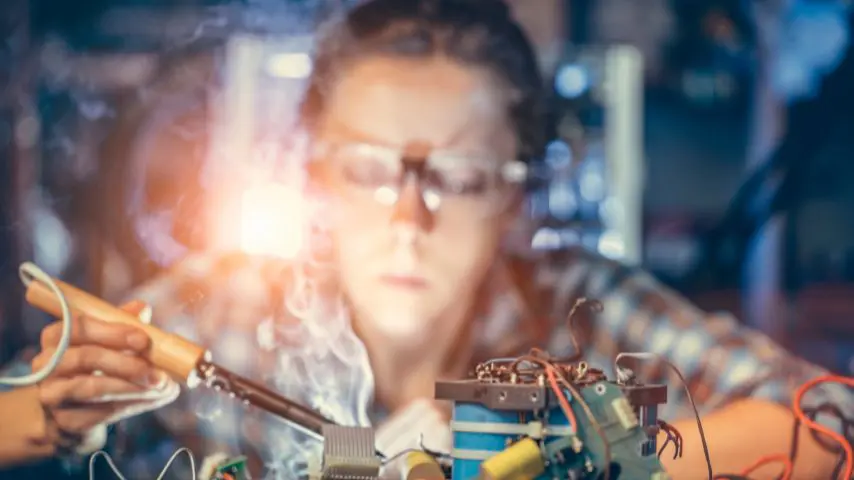A Better Approach to Teaching STEM
A Better Approach to Teaching STEM


To stay competitive as a nation, the U.S. needs more STEM (science, technology, engineering, and math) professionals who can be the next generation of scientists that creates new, innovative technologies and solves world problems. It is hard to be an international leader, however, when U.S. K-12 students have poor STEM performance and a decreasing interest in STEM careers.
As reported by the Pew Research Center, testing of 15-year-olds in dozens of countries placed the U.S. 35th out of 64 countries in math and 27th in science. In addition, fewer students are entering STEM fields, especially engineering. According to the National Science Foundation, although about one-third of all undergraduate degrees are in STEM, only five percent of them are in engineering.
"It is well known that the country's ability to succeed in the global economy is lagging and that we are losing our unrivaled edge in mathematics, science, and innovation to competitor nations," Sharon Robinson, president and chief executive for the American Association of Colleges for Teacher Education,told the U.S. Senate's STEM Education Caucus in June 2015.
Part of this poor performance results from the lack of a standard approach to recruiting, preparing, and retaining STEM teachers, which has resulted in a shortage of highly qualified instructors in these fields, which, in turn, threatens the nation's ability to compete in an innovative global economy.
Teaching STEM
Many universities have already initiated programs for training teachers to teach STEM courses, including engineering. For example, the University of Notre Dame’s Center for STEM Education provides programs for both teachers and students. The center collaborates with researchers and practitioners to help students innovate, engage, and excel in STEM. Programs include STEM summer boot camps for science and engineering that emphasize hands-on investigation and collaborative problem-solving.
“We are one of the few STEM centers that purposefully engages in both research and practice,” says Gina Navoa Svarovsky, a chemical engineer and assistant professor of practice at the Center for STEM Education. “Our work includes conducting innovative research and contributing to the field broadly, as well as translating research to practice for K-12 educators by providing high-quality professional development.”
To date, the center has provided professional development for about 100 educators and engaged about 200 students in STEM summer camps. “Many of the educators we've worked with have implemented new science and engineering activities within their classrooms,” she adds.
The Department of Civil and Environmental Engineering at Colorado State University is using a $593,000 grant from the National Science Foundation to provide teacher training for its engineering students. The funding will help add a teacher licensure option for engineering majors who are interested in teaching.
"Engineering students are well-trained in how to get young people to connect the STEM dots and understand the connections between the natural world and the designed world," says CSU engineering education professor MichaelDeMiranda. "Engineering students want to solve problems and make a difference in the world. Going into middle schools and high schools and preparing kids for the world we live in is another way for engineering students can help make the world a better place."
Private-Sector Engagement
Engineers don’t have to be university faculty to teach STEM. Private-sector engineering firms and professional engineers can also get involved. Companies can fund programs, send teams of engineers to do volunteering efforts, and host career days/events. Other ways professional engineers can engage include:
- Volunteer at local schools that have a STEM curriculum
- Volunteer with local after-school programs (for example, Odyssey of the Mind)
- Connect with local museums, science centers, and libraries about opportunities to engage the public about STEM
- Check out local makerspaces/maker programs
Messaging is important when teaching STEM to K-12. “There are lots of stereotypes out there that need to be corrected,” says Svarovsky. “Engineering is collaborative, meaningful, and can make direct and positive impact on people's lives. These themes need to be introduced to young people early, and reinforced throughout their early educational years.”
When working with young kids on engineering projects, adds Svarovsky, it's important to remember that they are “not mini-adults.” Most of them will not be able to fully integrate STEM concepts and practices the same way professional engineers do.
“But, even the youngest kids can start to develop engineering ways of thinking, such as generating multiple solution ideas, iterating on designs, testing to failure and using that feedback for the next iteration, working to meet a design goal, and considering constraints, tradeoffs, and optimization,” she says. “They won't be able to use the fancy terms that professionals use, but I've seen very young kids—even preschool age—begin to engage in these types of practices and ideas when working on engineering activities with adults.”
Mark Crawford is an independent writer.
Engineering is collaborative, meaningful, and can make direct and positive impact on people's lives. These themes need to be introduced to young people early, and reinforced throughout their early educational years.Prof. Gina Navoa Svarovsky, Center for STEM Education



